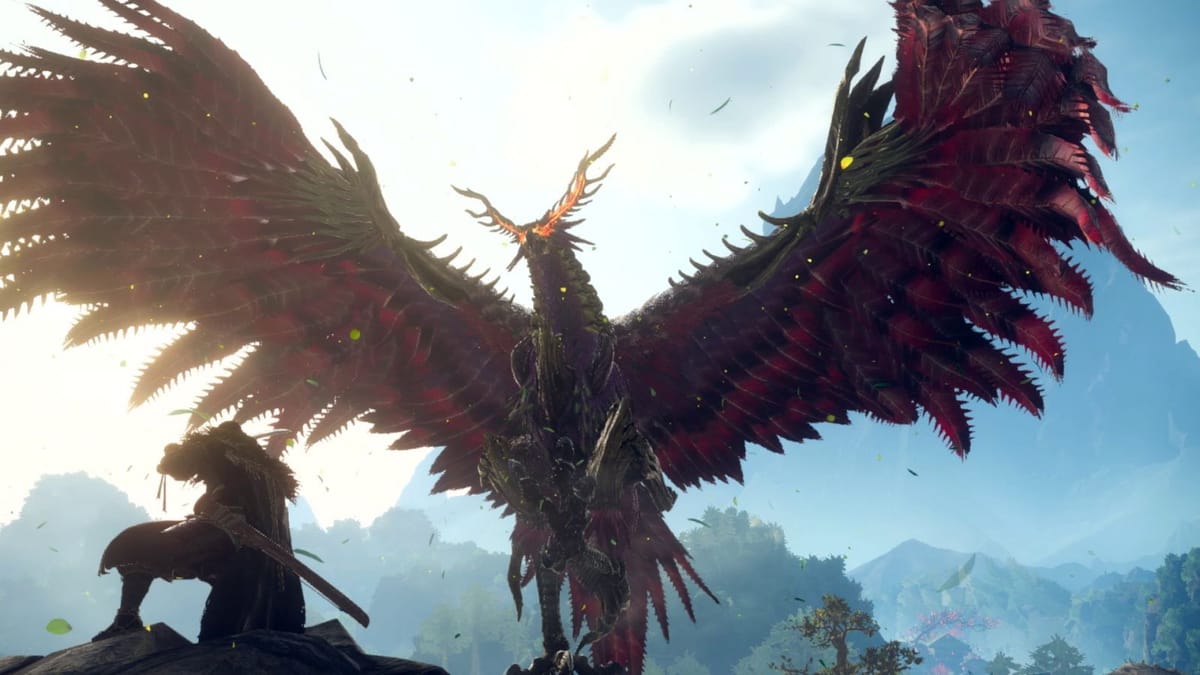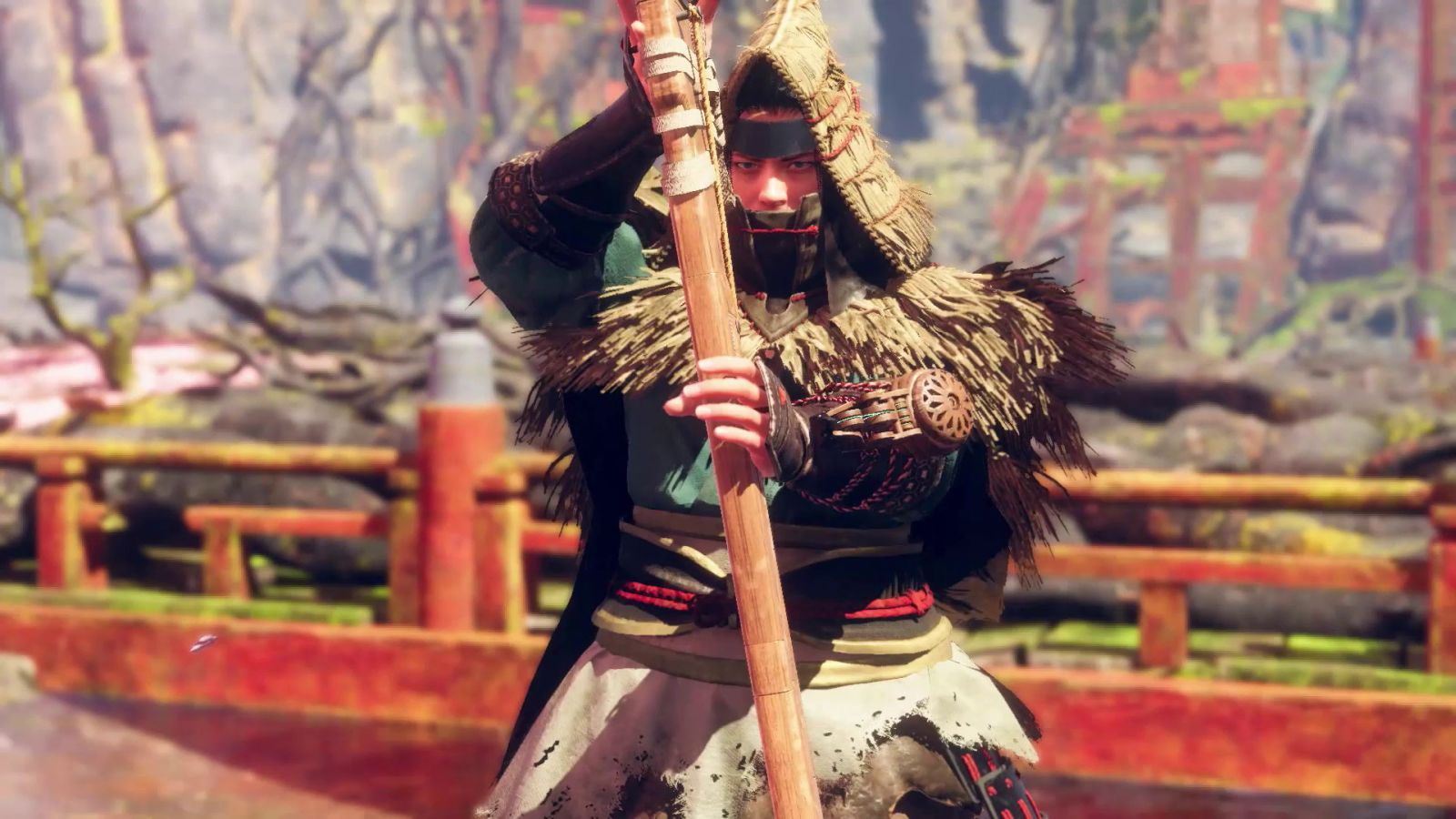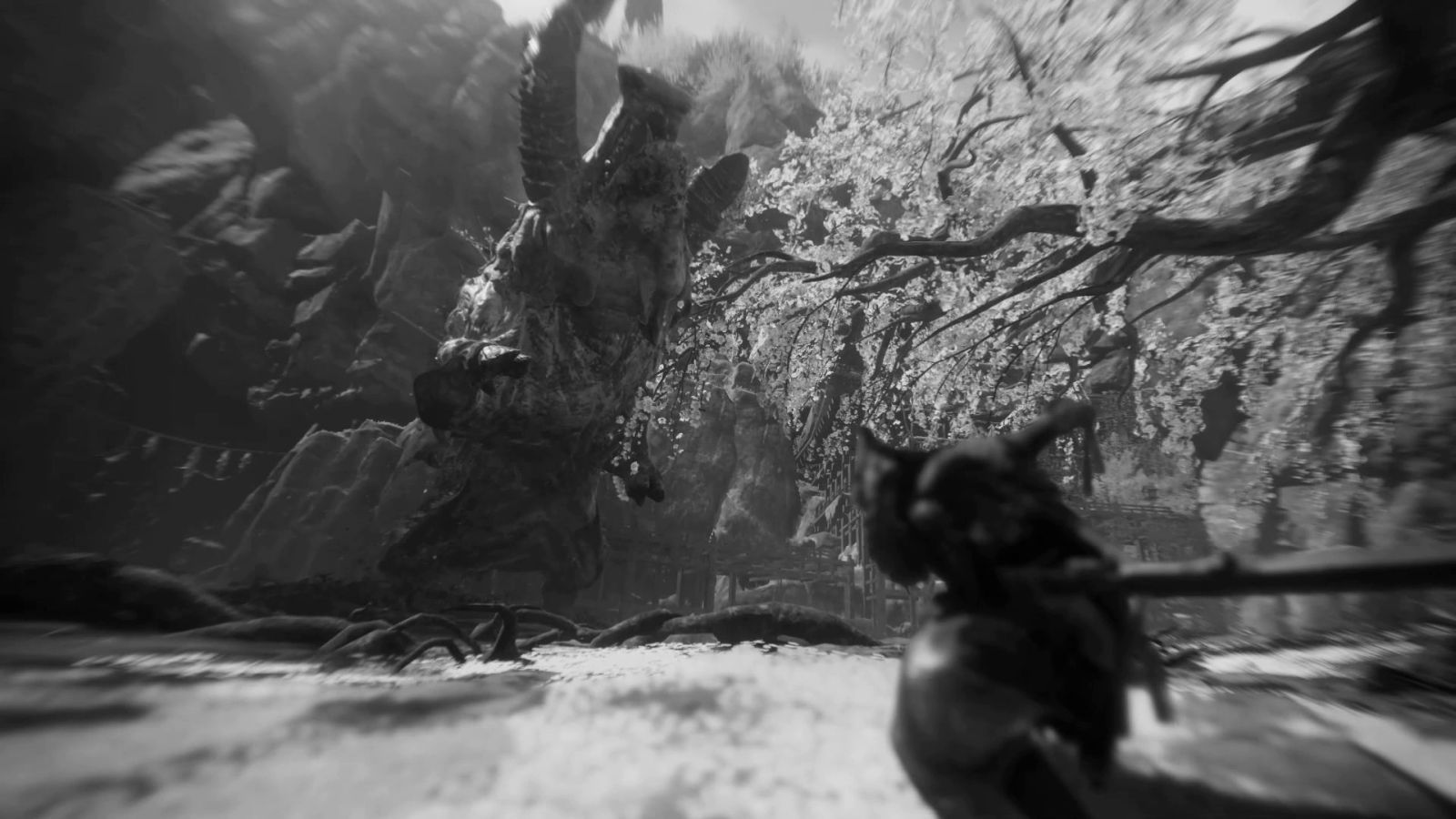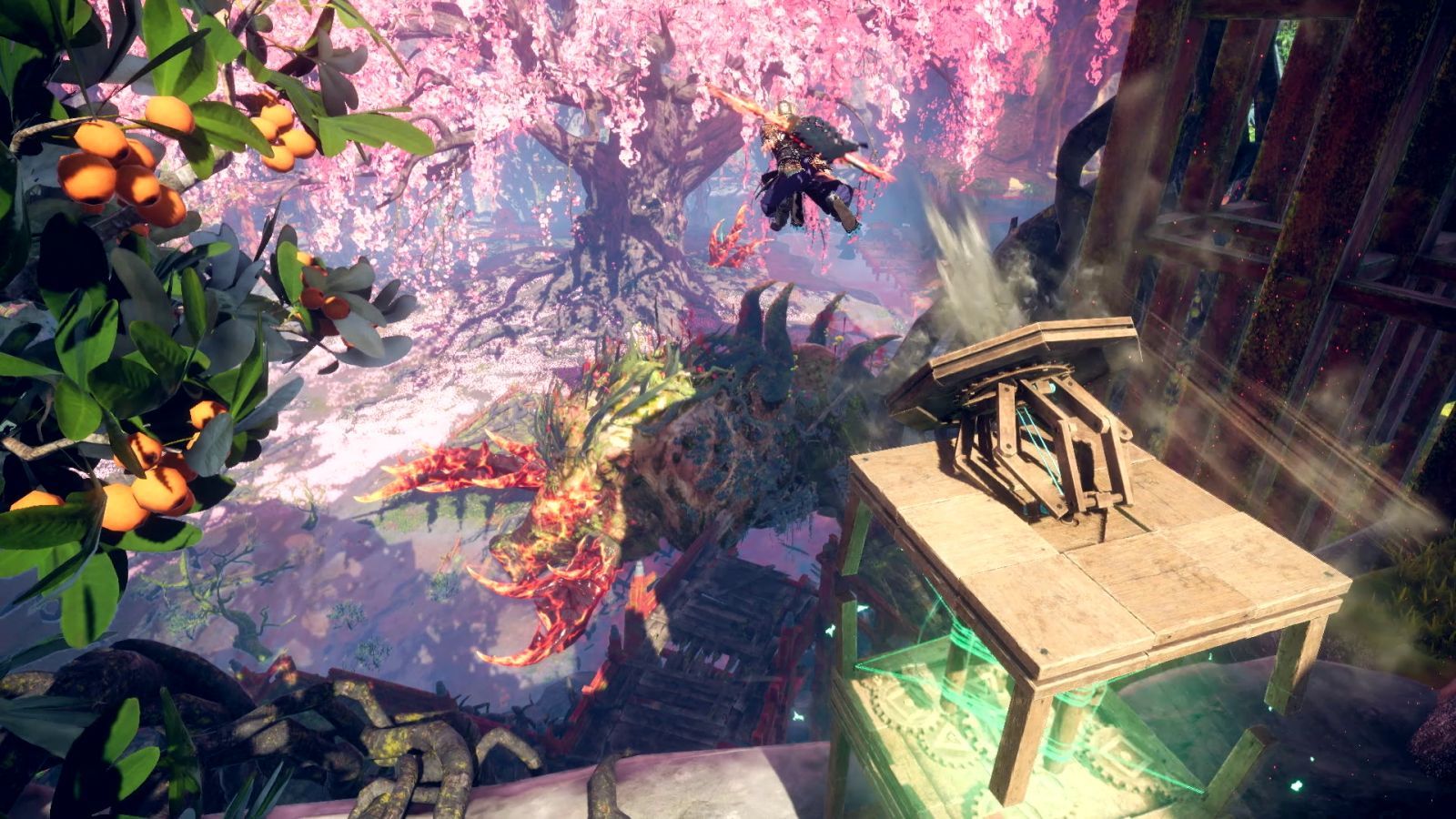
Omega Force, the team responsible for such games as the Dynasty Warriors series, Attack on Titan, Dragon Quest, Hyrule Warriors, Persona 5 Strikers, Dragon Quest Builders, and Fire Emblem Warriors are on a bit of a roll lately. They’ve put out some fantastic offshoots, and original titles these last few years, and now they are looking to tackle a behemoth of a genre – literally. Embarking on a partnership between Omega Force, Koei Tecmo, and Electronic Arts as part of their EA Originals program, the team is looking to bring all of their considerable talent to bear on a completely new genre for them – monster hunting. Their newest game, entitled Wild Hearts, is a single-player or cooperative hunting simulator that puts the player into a heavily stylized version of Japan of yore, battling massive fantastic creatures using fast-paced combat and a few new tricks that should shake up this genre nicely. We recently got to go hands-on with the game unsupervised for about three hours, showcasing the beginning of the game all the way through several big bosses. There’s a whole lot to unpack here, so strap in, hunter – you’ve got a lot to learn.
I don’t want to badmouth a competing product, but I feel like some direct comparisons are going to be made. Not all of them will be favorable. There are other hunting titles that require that the second player jump through an interminable amount of hoops just to join up with their friends. When IGN has to write a ‘how-to’ document on your multiplayer, you just might have made it needlessly complicated. One of the primary questions on my mind was whether or not Wild Hearts would feature gameplay that my friends and family could enjoy, some of them being either new to the genre, or new to gaming in general, and whether that would be immediately accessible without excessive hoop jumping. I was very pleased to hear that the game features drop-in / drop-out cooperative play, and that up to three people could play as a hunting party. The person hosting will further their narrative, and if you happen to be at that same stage, yours will advance as well. If not, well, you are just there to help. This means that players that are far further into the game can jump into your game and help you break an especially tough boss, or just join you for a bit of fun. The barriers to entry are gone, and I was overjoyed to hear it. The second question – whether or not my newbie friends and family could play the game would need a more hands-on approach.
The game opens in a gorgeous forest called the Sacred Mountain Foothill. It is lush and packed from wall to wall with greenery of all kinds. A moss covered the ground, leaves from the nearby bushes reached towards the sky, with overgrown roots crawling up the side of the trees. Everywhere you look, the world is alive with life. Small butterflies flit about, tiny birds zip through the skies, and then there’s the kemono.
Kemono, not to be confused with kimono, are a type of mythical beasts that inhabit the game. The first kemono you encounter are a sort of hybrid between a bird and a lizard, with a layer of moss covering their entire body. Running deeper into the forest, our primary target is a deer-like creature with a zebra-striped body and an otherworldly horn shape. In this first interaction with the kemono we were pursuing we made our first choice, and far from our last. Sneaking up on the creature we had the option to pet it, or finish it off. Choosing to pet it, I received a boon and then heard some music that caught my attention.
Nearby, an old man named Mujina with a monkey king mask and a beautiful Biwa – a short-necked traditional lute –, was found to be the source of the sound. Taking a break from his playing, the man asked us several questions about our upbringing, why we are pursuing the Kemono, and what our intentions are in this world. Several choices await us here, though it’s hard to say what sort of gameplay implications, if any, these have in the long run.
I handed the controller to my wife and turned her loose on the feudal Japan-inspired world of Azuma. She has the hang of using a mouse and keyboard, but controllers are a bit foreign to her, and she’s never played a game like this before. Before we could get to all of that, however, we had to make a not-so-brief pitstop at the character creator.
Personality and individuality are important in video games where you’ll be spending upwards of 30-40 hours playing a single character. Here we see a dozen presets, but that’ll just get you started. With an archetype selected, you gain access to a character customization engine that rivals the likes of Skyrim and Neverwinter. It’s not quite Black Desert Online levels, but it’ll more than do the trick. Facial shape, eyes and eyebrows, nose, mouth, ears, skin, markings, beard lengths and styles, nearly two dozen hairstyles (complete with two-toned highlights), undergarments, voice and personality, and how your equipment might be displayed are just scratching the surface. After spending a great deal of time making sure this temporary character was just right, my wife set off on her grand adventure.
The first thing she noticed was that the kemono appear to be twisted versions of their genus. Wolves from the icelands have evolved with wispy strands that flow off their fur, and a set of flowers on their tail that can only be a lure for prey. Laura engaged in combat with a frantic approach, mashing the buttons and taking them down in an inelegant fashion. Having put the three beasts down, she was presented with the chance to finish off the downed beasts. Not wanting them to suffer, she sheathed her sword, charged up for a moment, and executed a coup de grace. She was able to skin the creature – undoubtedly currency for future crafting opportunities. These small foes dispatched, Mujina warned of a far larger foe, a ringleader, awaiting us ahead.
Cresting the hill into the Snowmelt Pasture, Laura found a number of creatures running in the opposite direction – never a good sign. Ascending the mountain, she found the kemono responsible for the snowstorm – a massive wolf creature aptly named Deathstalker. This beast is mutated enough to control the very weather, turning the world into a prison of ice and snow. Thrashing wildly, our only defense was quick dodging. Moving quickly around the creature, she unsheathed her katana and began slide-evading the creature’s massive paw attacks. Simple attacks gave way to combinations as she got the hang of stringing her attacks together. A basic attack chained to an overhand slash which then connects to a double sword strike, and a spin finisher to close. She quickly learned how to dodge and slide, but the massive beast was more than undeterred. Striking a nearly fatal blow, it roared and loped over the hill. Wounded, she struggled to stand, only to find the ground giving way beneath her feet, plunging her into the cave recess below.
Awakening in a cave, our life begins to slip away. In the dark, a familiar face appears — Mujina. More than he appears, he saves you by weaving a seed into your soul, joining your life force with that of the karakuri – a mystical power that allows a hunter to manifest various objects into the world. To learn how to use them, however, we’d need to travel to Minato – the home of the hunters. It’s here that your journey begins, and it’s here where Wild Hearts showcases one of its biggest differentiators.
On your wrist has appeared a strange mechanical device, capable of spawning mystical shapes that you can use in combat. These objects very much resemble tensegrity tables, defying visual reality with cool physics manipulation. The first one you spawn is a small box that you can use to climb up a wall. Holding down the left bumper and then pressing X manifests the device, and running at it has the player automatically amble up it, launching them into the air. When you’ve finally unlocked, you can map up to four of these shapes, each with specific use cases, and a quick press of the left bumper and depressing the left stick will dissemble them. Before you can manifest these shapes, however, you’ll need karakuri thread. Mujina’s gift continues to deliver, as you can now emit a pulse of blue light called “Hunter Vision” that allows you to spot collectables and targets. With enough thread to build basic boxes, it was time to learn how to apply them to combat.
Climbing a nearby cliff Laura found a group of Kemono feeding on something, their backs turned. This would be our opportunity to learn how to combine the karakuri with combat. With the creatures distracted, Laura was able to drop a pair of boxes, scaling them and launching a massive overhead downward strike. While this game is absolutely flush with excellent little nods to classic Japanese cinema, jumping off this box immediately reminded me of classic anime. Hovering in the air slightly, our character pulled their katana, whipped it into position, and then hurtled down on top of our foe in a flash, striking deep. This first creature dispatched, the other two scattered. Using the box twice more, Laura struck down these last two, and here we saw another flair of the dramatic. Switching to a Kurasawa-esque tighter camera, Laura’s character sheathed her sword, dug her feet into the ground, and unleashed a lightning fast finishing blow.
Finishing our ascent out of the cave, we found ourselves in a forest clearing. A massive tree with an opening in the root base was shrouded in vines, revealing a small space where we could set up a camp. Here we’ll build a campfire, put up a hunter’s tent, and have to find some healing water to help with healing. It’s here that multiplayer becomes accessible, and your hunts begin. Setting out in the world, our first target is a 1 star Ragetail.
The world of Azuma is not a traditional open world, but it wouldn’t be disingenuous to call it at least semi-open. As Laura walked into the grassy space she immediately spotted her prey – a massive rat the size of a small house. Mutated, this creature has flowery pink blossoms across its back, a large pink blossom on its face, and a massive club-like green shell of some kind on its tail to use as a weapon. Almost immediately, the hunt was on and swords were out. Of note, the developers tell us that there are eight main weapons, with over 200 variants of each.
Tangling with the beast, eventually it decided that things were getting a little too hot for it and it ran. Pursuing the creature, time and time again, through various beautiful landscapes and even an overgrown shrine complete with Torii gates. Cornered, Laura dispatched the creature (albeit with two respawns as she was still learning the controls), and learned a new karakuri – a spring. While she could bounce off the top of the square ones, these round springs rocket the player forward. It’ll be interesting to see how this could affect both traversal, puzzles, and combat.
Heading back to the camp, we meet with a woman we’d rescued and healed at the camp prior. Her name is Natsume, and it turns out that she is a blacksmith. Good news, because we need new and better weapons for future hunts. Able to now build a field forge, we could now build upgrades for our existing weapons, or unlock new ones. Using some corestone, ancient wood, and gold, we could unlock a new attack for the katana, though further upgrades were gated behind later hunts. Each of the eight weapons would have their own unique upgrade paths, so you should be able to customize and grow your weapons to fit your play style. Similarly, your five categories of armor should provide some unique opportunities for upgrades, though the developers were also quick to point out that the game has a full transmogrification system, so there’s no need to look like a mismatched circus clown.
At this point we also got our first view of the karakuri options. There are well over a dozen of these shapes, and with four types being deployed simultaneously, there are some significant opportunities for new and creative ways to apply these in combat ahead. These are unlocked by retrieving kemono orbs, with more powerful karakuri requiring more dangerous hunts to unlock. Further unlocks are available, two for each karakuri, with things such as crafting tables and better food preparation techniques to provide additional bonuses in the field. There’s one unlock called “Flying Vine” that seemed fairly interesting, though we didn’t get to test it. It allows the user to fire an arrow, and then follow the path of that arrow. This has lots of problem solving implications as well as combat applications. You can also drop signs, so expect all sorts of “helpful” player information in the field.
At the end of her time with the game, Laura proudly proclaimed that this is a game she’d play, and with my hands-on time I have to agree. Many of the rough edges I’d experienced with other hunting games had been sanded smooth. Because this is a Koei Tecmo game, combat is king, and the simple controls hide the opportunity for complex and intricate combinations.
Honestly I could spend the length of this preview all over again and more talking through all the ways Wild Hearts seems to be reinventing the hunting genre in all the best ways, but I think my wife said it best when she asked “Hey, this was a lot of fun – when does it come out?” – that speaks volumes.
To answer her question, and yours, Wild Hearts comes out on PC, Xbox Series X and S, and PlayStation 5 on February 17th, 2023. Look for our continued coverage of this one right here at GamingTrend.com.






